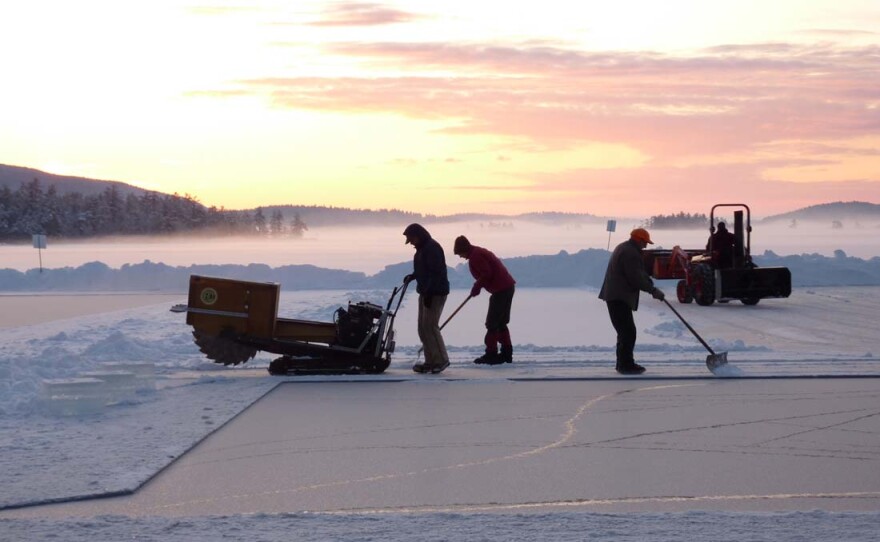In the 1800s, ice harvesting was a booming industry in New England. Now, only a few local communities continue the tradition of extracting ice from lakes in the wintertime to store for use year-round.
For Rockywold Deephaven Camps in Holderness, N.H., the lake ice serves as an attraction for hundreds of people daily.
Editor's note: We highly recommend listening to this story.

Taking advantage of their proximity to Squam Lake, each winter a group of camp workers and volunteers venture onto the lake’s surface to saw the ice into large blocks and float them to shore. Then, they haul the 200 tons of ice in trucks to the campgrounds.
Dave Lacasse, maintenance supervisor for the camp, helps make sure each guest’s ice box, a wooden chest lined with sheet metal, is stocked every morning.
His team digs out ice from one of the camp's ice sheds, where about six feet of ice blocks, each weighing roughly 120 pounds, are currently stored.

The blocks are covered in pine sawdust in the shaded sheds, which provides insulation for the ice to keep them cool all year, even in the summer heat.
But they do lose some ice due to melting, said Lacasse. He estimates they’ve lost about a foot of ice to the heat since the summer began.

Once the ice is unearthed with a shovel and pulled out of the shed, a worker will hose off the block, then hoist it into a green wheelbarrow to be transported around.

The camp almost decided to do away with the ice chests before he arrived, said Lacasse. They proposed replacing them with mini-fridges.
“And the guests complained so much that [staff] said, 'No, this is not going to work.'”

The process of getting the ice from the lake is the exciting part, said Lacasse. They have to walk – or drive – on the lake ice, which can be a bit scary at times.
“When you're out there, you hear the ice cracking all the time. And when you watch a truck pull away from the bridge, you can see the wave of the ice. You can't go too fast,” said Lacasse.
At Kezar Lake in North Sutton, married couple Pete and Marne Thompson are also keeping the practice of ice harvesting afloat. The Thompsons have been leading ice harvests for decades, helping make Muster Field Farm’s Ice Day event happen each winter.

Marne Thompson said the rank of volunteers is getting smaller each year, as older residents pass. The electric saw blade they use at Muster Field Farm will only cut through eight inches of ice. It takes another half hour to finish cutting up the block by hand.
But younger participants are starting to help out.
“You don't realize the little thing you could do to make it just a little bit easier,” she said. “But they can show us.”
The Thompsons said they’ve started noticing the window to get ice has been getting smaller – sometimes they have to wait until February. And one year, they couldn’t get out on the lake to harvest ice, so they took it from a small pond on the farm.
As climate change makes winters shorter and warmer in New Hampshire, there's less ice to come by in local lakes. Back in Holderness, Lacasse said their harvest this past winter was at the end of February– the latest it’s ever been.
“I don't know what will happen with climate change, and that's what worries me,” he said. “This past winter, I was really thinking, oh boy, I hope we get the ice in.”
Lacasse said they’ll keep up with the ice tradition as long as they can. For now, people are just enjoying it before it melts away.







